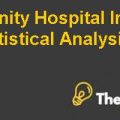
Another stakeholder that plays a major role in the management and organization of the team are the nurses working in the hospital. They are actively participating in the overall health care safety cause and always are ready to help the management in any way. For example, a nurse submitted a recommendation to organize a recycling program for juice containers. She pointed out that RDMH distributed three juice containers a day to every inpatient and on average two to every outpatient. These containers are then discarded and thrown out. However, a friend had told her that they could be returned to the local recycling company for cash. This recommendation was approved, and the juice containers were now collected every day and redeemed once a month. This money, roughly $5,000 a year, is placed into the general budget.
b) Which practices do you think are questionable and why? What factors have led to these questionable practices?
When Jordan looked at a further breakdown of the errors, she noted that 108 of the errors occurred during the administration of the doses compared to only one that occurred during physician ordering, 61 during transcription, and 26 during dispensing and delivery. However, when Jordan raised this issue with the nurses involved in the administration of the doses, she was reminded that few errors in the administration really occurred at other times but were only found when the medication reached the nursing unit.
In addition to these reported errors, Jordan knew that many errors went unreported because medication errors were reported voluntarily by the staff members who found the errors. Historically, the reaction to an error, throughout healthcare, had been to either hide the problem or assign blame to an individual and then punish that individual. Another challenge for small rural hospitals like RDMH is the availability and retention of health professionals. Due to the small number of beds, there are always challenges ensuring that specialist care is available when needed. For example, there is only one obstetrician in the community, pharmacists are in short supply across the province, and diagnostic imaging technicians are difficult to retain. Adding to this challenge is the relatively small volume of patients at RDMH, which is not large enough to sustain full-time health professionals in practice. In addition to this, another practice that is questionable in the hospital is related to the medication management. For instance, if a patient was discharged and still had medication left in the floor medication room, the nurses returned it to the pharmacy. Instead of discarding or destroying these medications, the pharmacy poured medications back into the stock bottles to be reused. Moreover, Jordan realized that a pharmacist was not available at all times when the expertise was required.
The best practice standard is for the pharmacist to check all medication prescriptions as they are delivered by the clerks to ensure that there would be no medication errors. The pharmacy technicians would then dispense and double check the prescriptions before they are picked up. However, even when the pharmacist is on duty, many medications left the pharmacy without the prescriptions being checked by a pharmacist.
c) Evaluate the options that must be considered. Be sure to include your goal, measurement criteria and analysis.
The success of any institution is dependent on the collaboration of all the stakeholders of an organization. In order to reduce the safety issues and to reduce medication related errors, RDMH wants all their stakeholders to take part to find the root cause so that the quality of service for patients can be increased. There has been an increase in pressure among the doctors, pharmacists and nurses at the hospital to reduce the adverse events that are happening. In order to this, the company can take various measures and alternatives to consider.
Bring improvements in the hand-hygiene compliance:
There is a high connection between various diseases and infections with dirty hands. Even the WTO is focusing, publicizing and emphasizing on the importance of washing hands. However, the rate in the hospitals for washing hands has lowered in the previous years. One who are underestimating the importance and significance of washing hands before giving any treatment to the patients are the nurses and doctors. Many researches have been done that shows that initiatives taken by the hospital always encourage all the stakeholders to implement and practice.....................................
This is just a sample partial case solution. Please place the order on the website to order your own originally done case solution.













